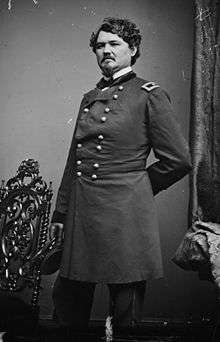Samuel D. Sturgis
| Samuel Davis Sturgis | |
|---|---|
 Samuel D. Sturgis | |
| Born |
June 11, 1822 Shippensburg, Pennsylvania |
| Died |
September 28, 1889 (aged 67) Saint Paul, Minnesota |
| Place of burial | Arlington National Cemetery |
| Allegiance |
United States of America Union |
| Service/branch |
United States Army Union Army |
| Years of service | 1846–1886 |
| Rank |
|
| Commands held |
6th U.S. Cavalry 7th U.S. Cavalry |
| Battles/wars | |
| Spouse(s) | Jerusha Wilcox Sturgis |
| Relations |
Jerusha Wilcox Sturgis (wife) James Garland "Jack" Sturgis (son) Samuel D. Sturgis, Jr. (son) Samuel D. Sturgis (grandson) Mary Brandenburg Sturgis (mother) James Sturgis (father) |
Samuel Davis Sturgis (June 11, 1822 – September 28, 1889) was an American military officer who served in the Mexican-American War, as a Union general in the American Civil War, and later in the Indian Wars.
Early life
Sturgis was born in Shippensburg, Pennsylvania. His parents were Mary Brandenburg and James Sturgis. He entered United States Military Academy at the age of twenty and was graduated 32/59 in the famous class of 1846 as a brevet second lieutenant in the 2nd U.S. Dragoons. That class also included among its graduates John Gibbon, George B. McClellan, Jesse Reno, and George Stoneman, who would fight on the Union side and Ambrose Powell Hill, Thomas Jonathan "Stonewall" Jackson, and George Pickett, who would fight on the Confederate side.
During the Mexican-American War, he served with the 1st U.S. Dragoons and was captured and held for eight days as a prisoner of war while making a reconnaissance near Buena Vista, Mexico. After the war, he served in the West, was promoted to first lieutenant and captain, and took part in a number of Indian campaigns. During this time, Sturgis was sent to West Ely, Missouri, where he met Jerusha Wilcox. In 1851 they married and had six children.[1]
Civil War
When the Civil War broke out, Sturgis served in the 1st U.S. Cavalry. He was promoted to major and in August 1861, at the Battle of Wilson's Creek, he succeeded to command of the Federal forces after the death of Brig. Gen. Nathaniel Lyon. In March 1862 he was appointed brigadier general of volunteers to rank from August 10, 1861, the day of the battle.
After a tour of duty in the Washington, D.C., defenses, he was ordered to the front to support General John Pope's Army of Virginia just prior to the Second Battle of Bull Run. While attempting to secure priority from General Herman Haupt for movement of his troops on the railroad, he was told that he must wait his turn as other troops and supplies were going forward to support Pope. His reaction was his now-famous remark, "I don't care for John Pope one pinch of owl dung."
Sturgis then commanded the 2nd Division in the IX Corps at the battles of South Mountain, Antietam, and Fredericksburg.
He went west with IX Corps in 1863 and later had a number of relatively unimportant commands in Tennessee and Mississippi. He also served as Chief of Cavalry of the Department of the Ohio. In June 1864 he was routed by Nathan Bedford Forrest at the Battle of Brice's Crossroads in Mississippi, an encounter that effectively ended his Civil War service.
Postbellum service
Sturgis was breveted brigadier general (for South Mountain) and major general (for Fredericksburg), regular army, in March 1865 and mustered out of the volunteer service in August. He reverted to his regular rank of lieutenant colonel of the 6th U.S. Cavalry. On May 6, 1869, he became colonel and commander of the 7th U.S. Cavalry and his lieutenant colonel was George Armstrong Custer.
Sturgis was on detached duty at St. Louis, Missouri when parts of the 7th Cavalry were destroyed at the Battle of Little Big Horn. (One of Sturgis's sons, Second Lieutenant James G. Sturgis, was also an officer with the 7th and was killed in that battle.) Samuel Sturgis then took personal command of the regiment and led the 7th Cavalry in the campaign against the Nez Percé in 1877. Sturgis and his soldiers headed off the Nez Perce and waited to attack them after when they emerged from their passage through the wilderness of Yellowstone Park. The Indians deceived Sturgis with a feint and eluded him, continuing their flight northward toward Canada. Sturgis soon caught up with the Nez Perce but at the Battle of Canyon Creek, the Indians, although outnumbered two to one, again escaped from his grasp.[2]
Sturgis retired in 1886 and died at Saint Paul, Minnesota. He is buried at Arlington National Cemetery. His son Samuel D. Sturgis, Jr. became a general in the United States Army, and was a division commander in the American Expeditionary Force during World War I. His grandson Samuel D. Sturgis, Jr. also became a general in the United States Army and served as Chief of Engineers from 1953-1956.
Legacy
The city of Sturgis, South Dakota, is named for Samuel D. Sturgis.[3] A sculpture of him mounted on horseback is located at the eastern entrance of the town on South Dakota Highway 34 and 79.
USS General S. D. Sturgis (AP-137), a World War II troop transport ship was named in his honor.
See also
References
- ↑ Sturgis, Jerusha Wilcox, Life of Mrs. S. D. Sturgis, U.S. Military Academy Library, West Point, New York
- ↑ "Battle of Canyon Creek Photo Tour" http://friendsnezpercebattlefields.org/battlecanyoncreekphototour.htm, accessed 3 Dec 2012
- ↑ Chicago and North Western Railway Company (1908). A History of the Origin of the Place Names Connected with the Chicago & North Western and Chicago, St. Paul, Minneapolis & Omaha Railways. p. 128.
- Eicher, John H., and Eicher, David J., Civil War High Commands, Stanford University Press, 2001, ISBN 0-8047-3641-3.
External links
- "Samuel D. Sturgis". Find a Grave. Retrieved 2009-05-12.
- Sturgis, Samuel Davis - American National Biography